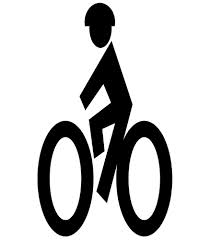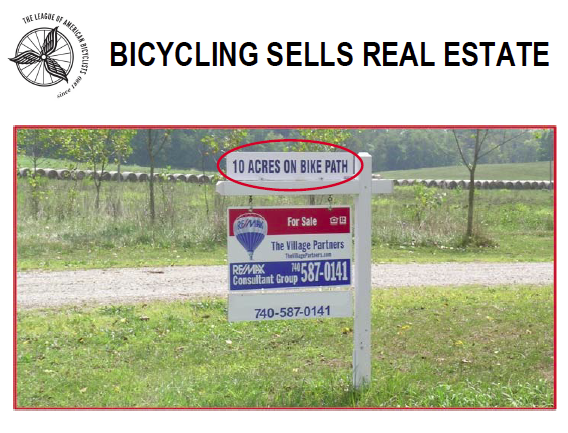 BESIDES THE OBVIOUS BENEFITS OF BICYCLING related to fun, health and inexpensive transportation, there is “gold” in those bicycle wheels for a wide sector of the economy.
BESIDES THE OBVIOUS BENEFITS OF BICYCLING related to fun, health and inexpensive transportation, there is “gold” in those bicycle wheels for a wide sector of the economy.
Who knew?
 I’ve mentioned in past articles that one of the many goals the Community Sustainability Commission has set to work on for 2013-14 is a Bicycle Guide for Benicia. To learn more about community “bikeability” and other benefits of bicycling, I started research on the Internet and in my university’s library. I found an astounding number of Internet hits for the word “bicycle” — more than 200 million.
I’ve mentioned in past articles that one of the many goals the Community Sustainability Commission has set to work on for 2013-14 is a Bicycle Guide for Benicia. To learn more about community “bikeability” and other benefits of bicycling, I started research on the Internet and in my university’s library. I found an astounding number of Internet hits for the word “bicycle” — more than 200 million.
What I have been able to cull from this abundance, however, are some interesting data about the economic benefits of bicycling for a community. Some of these benefits we already enjoy in Benicia — and I would certainly like to see even more!
Bicycle tourism and other dollars
Benicia is a perfect bicycle tour destination. What’s not to love about our town? We have beautifully dramatic scenery, a great First Street commercial area with food and shops, an inspiring artist community with galleries and studios, fantastic accommodations and lots of fascinating historical points of interest. Further, we can now be safely reached by bicycle from either Vallejo or Martinez!
The League of American Bicyclists put together a presentation titled, “Bicycling Means Business,” and it found that those who bicycle and spend money are those who:
• Are highly educated
• Have higher discretionary income
• Spend more than the average tourist
• Tend to stay longer in an area
• Have less direct impact on local environments
• Like “green” travel potential and linkage with trains and buses (remember, AMTRAK stops in Suisun and Martinez — how perfect for bicycle tourists!)
Further, consumer spending in 2010 by 50-64-year-olds (those who are represented in the tourism demographics) accounted for a 43-percent increase in spending. Wisconsin attributed $1.5 billion to bicycling, with approximately $534 million of that coming from out-of-state bicyclists. Minnesota attributed $427 million for recreational road and mountain biking (Wisconsin IS flatter than Minnesota).
And think of it, these are states with a very short bicycling season.
A 2012 study, “Average Per Capita Spending by Transportation Mode” for the East Village of New York City, showed that bicyclists were the big spenders, spending $163 compared to $143 by people who drove cars.
And a tidbit pulled from the Marin County Bicycle Coalition’s website: “The average cyclist who stops to eat spends nearly $18 in Ohio, $23 in Colorado and $34 in California.”
Real estate
Being “walkable” and, therefore, “bikeable” has been found to increase a home’s assessed value by “$700 to $3,000 for every one-point increase in the Walk Score,” according to the 2009 “CEOs for Cities” study.
I was fascinated by the idea of a “Walk Score,” so I checked out the 2009 study, which referenced an earlier 2007 survey commissioned by the National Association of Realtors. The 2007 survey “showed that 57 percent of Americans agreed with the statement that ‘business and homes should be built closer together, so that stores and shops are within walking distance and don’t require the use of an automobile.’ Well, in Benicia we may not be able to easily accomplish rebuilding, but by hopping on a bicycle we can shorten the time distance between our destinations.
 Having just sold my family’s home in Maplewood, Minn. last year, I know that a strong selling point was the city-maintained walking/bicycle path at the foot of our home’s backyard hill (above).
Having just sold my family’s home in Maplewood, Minn. last year, I know that a strong selling point was the city-maintained walking/bicycle path at the foot of our home’s backyard hill (above).
Health care savings
A cutting-edge business in Bloomington, Minn., Quality Bicycle Parts, launched a bike-to-work incentive in which they provided employees with a place to shower, secure parking and $3 a day for each day they bicycled to work. From 2009-11 they found a 4.4-percent per-member, per-month decrease in health care costs. With 464 employees, their three-year health costs savings amounted to $169,880! And this was during a period when average health care costs increased by 24 percent!
Behind these savings for the company is the improved health and, hopefully, fitness of employees! Nice!
Money in the bank
Anytime you are able to walk or bicycle, you are keeping money in the bank or in your wallet. The cost of riding a bicycle is virtually nil compared to driving a car. If you upgrade your ride with an electric bicycle, the costs range from 1 to 3 cents a mile for charging a battery.
AAA’s 2013 study of annual driving costs is based on 15,000 miles. For 2013 the driving costs were $9,122. Saving even 10 percent of that average mileage by bicycling would keep more than $900 in your pocket.
Saving money is always good and to think of it, these bicyclists, according to the data above, are possibly spending their savings shopping or dining!
Surveys
Over the next few weeks, some of you may see a “How Bikeable is Benicia?” survey. I hope you’ll take the time to respond. It shouldn’t take longer than 5 to 10 minutes to complete and we hope to learn how to celebrate and improve bicycling here.
If you would like to take part in the survey, send me an email at cmbeutel@sbcglobal.net and I’ll be sure you get one.
CSC grant cycle — deadline April 18
If you or your company has a project that will help Benicia reduce greenhouse gas emissions, I encourage you to submit a Community Sustainability Commission grant application. This is a great win-win for Benicia and Benicians/Benicia enterprises. Check out the link to the application and criteria below.
Learn more
• Community Sustainability Commission Grants: Search “CSC Grants on the city of Benicia website”: or CLICK HERE.
• Health care savings: streetsblog.org/wp-content/uploads/2012/03/Quality-Bike-Products-Health-Reward-Program.pdf
• League of American Bicyclists: bikeleague.org
• Walk Scores and real estate values: ceosforcities.org/research/walking-the-walk/
Constance Beutel is a member of Benicia’s Community Sustainability Commission. She is a university professor and videographer and holds a doctorate from the University of San Francisco.






Leave a Reply